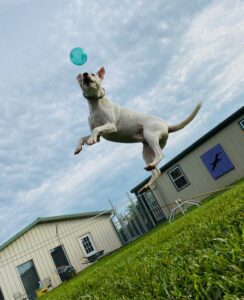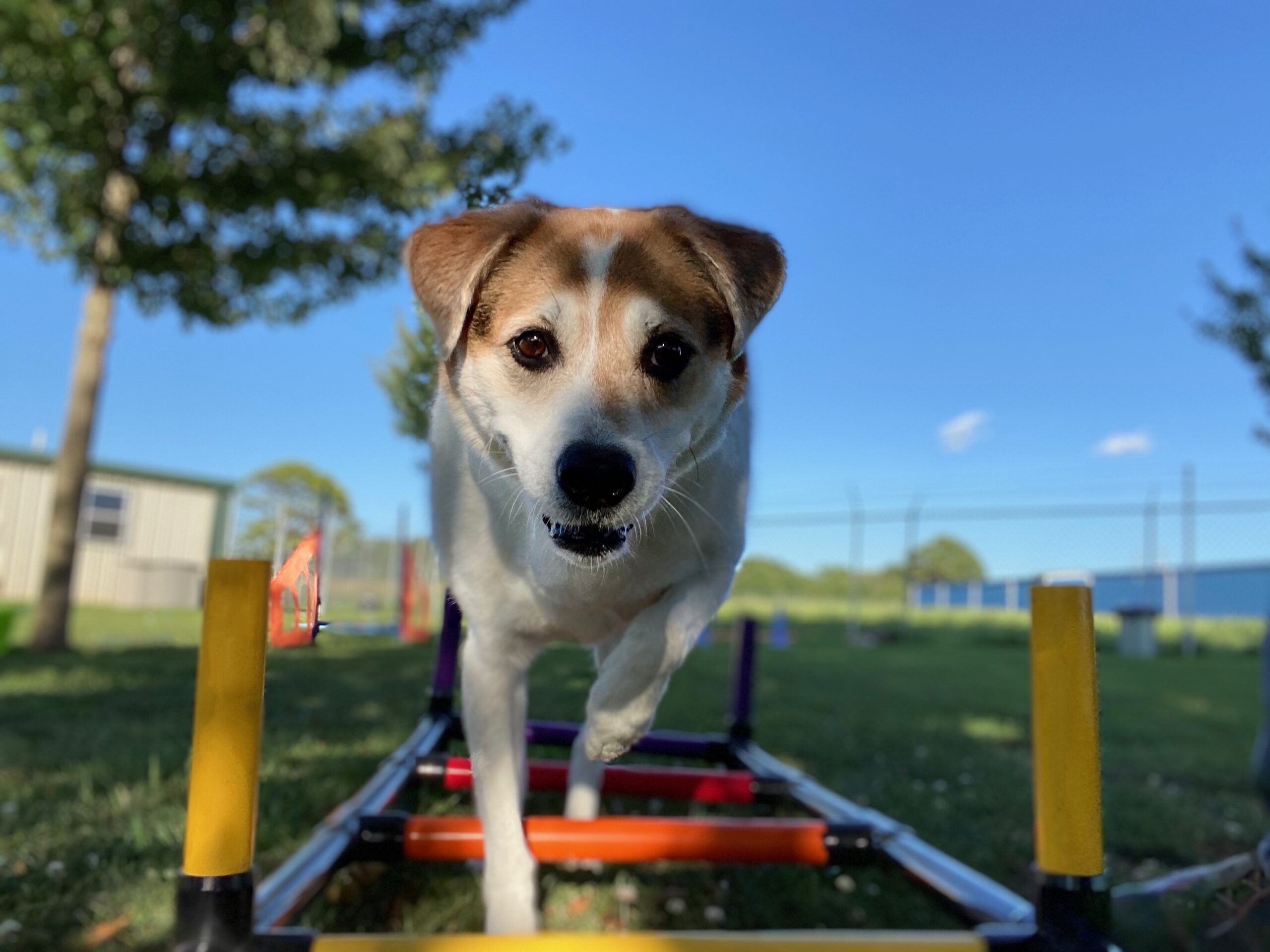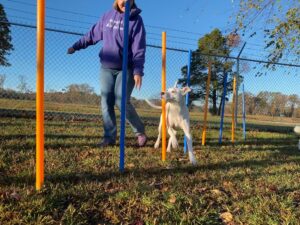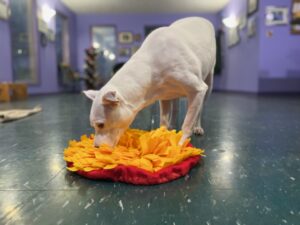Barks Blog
A New Trend in Dog Boarding
By Rachel Brix

Pioneered by Dr. Hal Markowitz in the 1960s, enrichment originated from a focus on zoo animals. He called zoos “concrete wastelands” (Bender & Strong, 2019) and was determined to improve the animals’ lives in captivity. He first developed ethograms, or inventories of behaviors, for each species; then, after determining the animals’ needs, came the task of how to meet those needs in captivity.
Our pet dogs, although not captive wild animals, still have instinctual and natural behaviors. Although domestication has softened many of these behaviors, as we continue to look to improve our dogs’ lives and our relationships with them, we must still consider their species-specific needs and create enrichment programs and protocols to meet them.
One essential for dogs is sensory stimulation, especially the sense of smell. Additional needs include food-related behaviors such as scavenging and foraging; many dogs love to work for their food. Emotional needs include security and safety and relationship and social needs.
Agency and environment are vital for a dog’s sense of security, independence and confidence. And dogs often love to problem solve too. Simply put, enrichment is about engagement: actively engaging our dogs in ways that encourage their willing participation and fulfill as many of their needs as possible.
Our late, great husky mix Percy gave us our first lessons in enrichment many years ago. So we designed our boarding and training facility, Percy’s Playground, to fulfill two main goals: enrichment and education. We focus on connecting the enrichment we do with the dogs in our care with how pet parents can continue and enhance the program at home thereby improving relationships and the dogs’ quality of life.
Currently we offer day stays, boarding and training. The first main priority at our facility is being force-free and fear-free. To that end, our approach prioritizes making sure our guest dogs are as safe and secure as possible, distinguishing between the two as being free from harm and feeling free from harm, respectively.
Individualized Enrichment
To best focus on as many aspects of individualized enrichment as possible, we completely forego playgroups at our facility. Instead, each dog gets multiple one-on-one outings each day with a human, taking part in all kinds of activities, from scent work to agility, to foraging to fetch, to task training to simply sitting and getting lots of pets and tummy rubs, and many things in between.
Each dog gets to choose how they spend their time in one of our completely fenced outdoor play yards or in our indoor play area. We are a cage-free facility, and our guest dogs enjoy spaces that are 85 sq ft and 160 sq ft, which includes 100 sq ft of personal patio space.
This allows dogs to make choices about how they use their space and provides a comfortable respite for much-needed downtime and naps throughout the day. We can also engage our guest dogs in a variety of activities in their personal space if they so choose, especially on inclement weather days.

preferences of each individual dog, can form an integral part of a boarding facility’s enrichment program © Ryan Brix
Relationship building with both our four-legged and two-legged clients is a major component of our enrichment protocol. As a first step in the process of creating individual enrichment programs for each guest dog we have a comprehensive profile form completed by each pet parent; then we require a meet and greet. Our dog-centered introductory meetings provide the opportunity for each dog to become familiar with us and our facility in a fun way.
We also establish rapport with their humans by reviewing their dog’s profile with them, giving them a tour and encouraging questions and dialogue. By enveloping the pet parents in the process we are setting up both dog and guardian for at-home enrichment success.
If, at the meet and greet, we observe a dog to be nervous or hesitant, we might recommend an abbreviated day stay (a few hours) and work up to longer stays. For more moderate to severe cases we recommend a certified behavior consultant or even a behaviorist whereby we can partner on a behavior modification plan. In such cases we may recommend a dog stay with a friend, family member or even a pet sitter who we can refer them to.
While sometimes it affects our bottom line, we would much rather see a dog happy and secure at home in a familiar environment than stressed in ours until behavior modification and training can take place. Our goal is to minimize stress, fear and anxiety.
When we meet dogs who aren’t good candidates for boarding most pet parents are grateful for the help and suggestions as the dog’s issues are, typically, not new. As such we’ve developed a niche for first-time boarders, from puppies to seniors, whose humans haven’t previously felt comfortable enough to leave them anywhere before.
Our human clients overwhelmingly say the human interaction is their most favorite part about our facility, i.e. knowing their dogs will get lots of human interaction.
Empowerment through Choice
Once in our care, we work to quickly establish our routine with each dog. We allow for individual differences to focus on environmental and calming enrichment. For example, how the dogs enter and exit their space, how we enter and exit their space, what type of bedding they receive or what kind of water bowl they need.
As an example, we had a pit mix stay with us who was only drinking out of either the hose or the bathtub at home. Because we spend so much one-on-one time with our guest dogs, we were able to help this dog choose a bowl she found acceptable and spend time training her to use it. As part of our calming enrichment we utilize dog-friendly essential oils and provide a variety of music from streaming classical to my husband playing acoustic guitar lullabies at night.
Another one of our priorities is giving each guest dog as much agency, or empowering them with choices, as we can. One of the main ways we provide choice is by allowing each guest dog to decide what they will do on any given outing. Sometimes that might be agility or the German-born activity, degility.

Degility combines agility, parkour and fitness and focuses on dogs who are impaired, senior, not as active as they once were or even dogs who can benefit from confidence building. Sometimes that might be scent work activities, digging or foraging, or fun with a flirt pole.
A flirt pole (basically an oversized cat toy) provides an outlet for instinctual behaviors such as stalking, chasing and herding (mental and physical exercise). It also allows for some additional mental exercise by way of training (drop it and get it). Tossing a treat for dogs to find for dropping it adds a smidge of scent work too. Some of our guest dogs thrive on playing fetch or tug (by the rules) and we’ve taught many dogs how to catch flying discs. All these activities can be continued by the dog’s humans once they get back home.
Admittedly, when we first opened, a lot of people were skeptical as to whether we would be successful because we don’t incorporate playgroups into our enrichment protocols. Some potential clients even avoid our services entirely under the impression that, without playgroups their dogs wouldn’t get what they need, would be bored, or wouldn’t be tired when they got home.
For us, however, even well-structured playgroups just don’t provide for the enrichment and type of interaction we want to have with both our canine and human clients.
Furthermore, adult dogs don’t necessarily always want to play with other dogs. States Antoniak-Mitchell (2013): “Dog owners often have a hard time accepting that most adult dogs don’t need or want to ‘play’ with other dogs in the same way puppies do…As puppies mature the need for this type of interaction [learning social and survival skills] with other dogs naturally diminishes. [Especially] dogs who have been bred to work alone often lose their desire to play with other dogs far sooner than those dogs who have been bred to work more closely with other dogs.”
Moreover, a lot of stress can result without proper management and downtime even if dogs are dog-social. And dogs may fall into the dog-tolerant, dog-selective, or even dog-aggressive categories and simply not thrive in playgroups. And if that’s the only option a dog has for his whole day, stress, anxiety, fear, and even flooding can result – especially for extended stays.
Social Interaction
Also, in our experience, social interactions seem to be the easiest and most common enrichment pet parents are already providing for their dogs, in addition to physical exercise. Many guardians already take their dogs to dog parks, on play dates, or other places where people and dogs congregate.
But surprisingly, a small number of our two-legged clients actually play with their dogs; not because they don’t love them, but — in our experience at least — because they either don’t really know how to engage their dogs in play, don’t realize how important play and enrichment are for a dog’s overall well-being, or simply think their dogs aren’t interested in toys and good-for-dogs activities.
As a matter of fact, on a surprising number of our comprehensive dog profiles, pet parents indicate their dogs don’t like toys or don’t like playing with toys. However, oftentimes we find their dogs, regardless of breed or age, really do enjoy engaging in play, often with multiple types of toys or engaging in different types of activities. Therefore, we’re able to make solid recommendations to help take the guesswork out of what dog guardians should buy or try with their dogs to help facilitate at-home continuance of the enrichment fun.
We’ve also found a significant number of pet parents free feed and have food available to their dogs at all times. We have to feed our pets anyway, so instead of free feeding we suggest this can be a prime time to include enrichment. It’s a great way to stimulate dogs without spending a ton of extra time, which our busy clients don’t often have in abundance, so they really appreciate the suggestions of puzzle feeders, snuffle mats and scatter feeding; and with a few extra minutes even hiding kibble in boxes or around the house.

Feeding is also a great time to work in short training sessions (the best form of mental exercise) to have dogs work for even part of their meals. At our facility we find that feeding time is a fitting time to incorporate training, foraging and scavenging enrichment. There’s no shortage of ways to enrich dogs’ lives through their meals.
Additionally, since a dog’s expression of natural behavior may sometimes be perceived as inappropriate or “bad” by their guardians, our approach affords the perfect opportunity for us to work together with the humans on a training plan whereby they can show their dogs what to do.
For example, instead of the dog getting into the trash or onto the kitchen counter we suggest ways to add appropriate enrichment to fulfill the need to scavenge. Or propose ideas for management in addition to training, such as using a sandbox/dig box as a solution for digging in the vegetable garden.
Preferences
After a visit or two to our facility, we’re able to work with pet parents to help them incorporate enrichment specific to their dog’s preferences and needs. A lot of our recommendations are cheap (or free) and easily incorporated into busy daily living.
Establishing this line of communication not only helps foster great relationships with our human clients, but also facilitates making the most out of each visit with their beloved dogs. We love having clients come in and tell us they recently sewed their own snuffle mat and Fluffy can’t get enough of foraging for her supper. Or when they tell us they didn’t realize their senior dog still loved to fetch or didn’t think she could do (or would like) low impact agility or degility. Many clients have even told us their dogs overall seem happier and more energetic since coming to our facility on a regular basis.
Essentially, we view enrichment as advocating for dogs: Advocating for their well-being in our care and in their lives with their humans. All dogs benefit from enrichment, and the humans benefit by cultivating a deeper connection with their dogs. And that’s a beautiful thing.
References
Antoniak-Mitchell, D. (2013). Terrier-Centric Dog Training: From Tenacious to Tremendous. Wenatchee, WA: Dogwise Publishing
Bender, A., & Strong, E. (2019). Canine Enrichment for the Real World: Making It a Part of Your Dog’s Daily Life. Wenatchee, WA: Dogwise Publishing
Resources
Coleman, S. (2020). 5 Reasons NOT to Free-Feed Your Dog. Whole Dog Journal
Degility
Kelly, S. (2019). Canine Enrichment: The Book Your Dog Needs You to Read. (n.p.): Author
Maple, T.L. (2013). Remembering Hal Markowitz. Zoo Biology 32 (3)
This article was first published in BARKS from the Guild, March 2021, pp.22-26. Read the full article A New Trend in Dog Boarding.
For more great content on all things animal behavior and training, you can sign up for a lifetime, free of charge, subscription to the digital edition of BARKS from the Guild. If you are already a subscriber, you can view the issue here.
About the Author
Rachel Brix BSEd CPDT-KA is Fear Free certified and has been training dogs and teaching people for a combined 20 years. Also a writer and speaker, she has spoken twice at the annual APDT Conference and has been nominated back-to-back years for a Dog Writers Association of American Award. She owns and operates Percy’s Playground boarding and training facility in Eagle Rock, Missouri with her husband, who also helps her train – and spoil – their six rescue animals.

